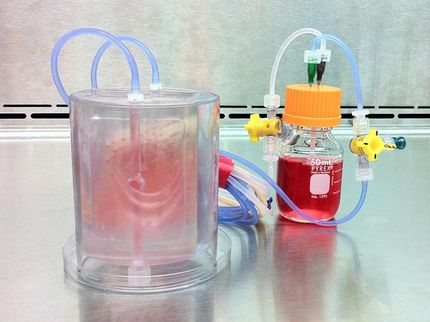3D-architectured hydrogels guide regeneration of critically sized bone defects
Inducing and controlling the regeneration of tissues by implantation of biomaterials is a preeminent goal of regenerative medicine. Critical size bone defects are an example for an often occurring clinical challenge. Scientists of the German Institute of Biomaterial Science together with scientists from Berlin and Rostock reported on a purely polymeric 3D-architectured hydrogel (ArcGel), which successfully guided the in vivo bone regeneration in rats. The biological effect is purely material driven, an addition of cells or bioactive factors is not required.
The design principle for ArcGels was going beyond compromises in multifunctionality. The complex requirements for functions were realized by a hierarchical organization of the hydrogel, in which different functions were implemented at different levels. The multifunctional material is build up only from amino acids, with the material being synthesized and shaped in an integrated one-step procedure.
The molecular level is associated to cell adhesion and hydrolytic degradability, the level of pore walls relates to local mechanics and tension of polymer chains, while the porous architecture enables cell invasion, form stability, and shape recovery. The macroscopic level is related to the elastic recoverability with a defined compression module. The implementation of the functions on different levels enables adjusting of local elasticities independently from macroscopic mechanical properties.
Furthermore, ArcGels show a water-induced shape-memory effect. The ArcGels display a unique degradation profile with pore size growth similar to merging soap bubbles during the course of hydrolytic degradation while ensuring material integrity. Implanted in a critical bone defect in a rat model, a comparable healing capacity induced by an ArcGel to that of the clinical standard, cancellous bone graft was observed. It is remarkable that a rapidly degrading material can induce such an osteoinductive effect.
Original publication
Other news from the department science

Get the life science industry in your inbox
By submitting this form you agree that LUMITOS AG will send you the newsletter(s) selected above by email. Your data will not be passed on to third parties. Your data will be stored and processed in accordance with our data protection regulations. LUMITOS may contact you by email for the purpose of advertising or market and opinion surveys. You can revoke your consent at any time without giving reasons to LUMITOS AG, Ernst-Augustin-Str. 2, 12489 Berlin, Germany or by e-mail at revoke@lumitos.com with effect for the future. In addition, each email contains a link to unsubscribe from the corresponding newsletter.


















































